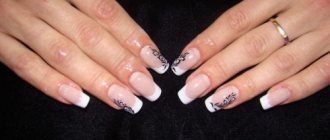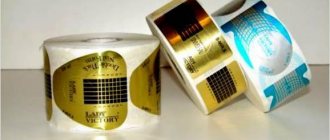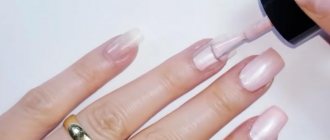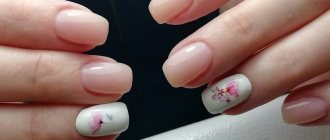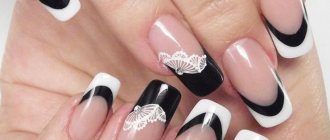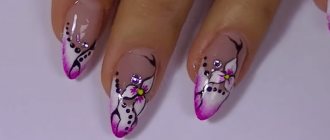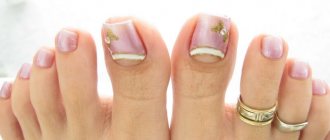This is an eternal question that torments our clients and because of which disputes between specialists constantly occur: which extension is better on tips or on forms? Naturally, every master proves that his extension technology, which he uses, is the best. In fact, the opposition of these two technologies usually leads to a dead end, since a master who masters both of these technologies can make nails in such a way that it is almost impossible to distinguish tips from forms. The modeling method is most often selected by the master and depends on the shape and condition of the client’s nails.
| 1. If the client’s nails are normal, have a regular, almond-shaped shape, then there will be no problems with choosing an extension method and the master can offer any of two shapes or tips. 2. If the shape of the nail is flat, then in this case you can also choose any of the two methods, but taking into account the following nuances: If flat nails are wide enough, then it is better to use forms, because the master may simply not choose tips of the appropriate size, If the client insists on extensions with tips, then it is necessary to first cut down the contact area of the tips to the required size. 3. If your nails are bitten, it is better to apply extensions using tips with a small contact area. The surface of bitten nails is always uneven; the nail seems to sink into the high pads of the fingers. In this case, the craftsman needs to carefully file away all the irregularities and create a smooth surface for gluing the tips. 4. If the nails are bent downwards, then it is better to carry out extensions on forms. Moreover, the shape must be selected along the smile line to match the natural nail. If only universal forms are available, then before extensions it is necessary to cut out the necessary smile line in them and glue them from the wrong side to the area where the free edge is formed, which will significantly strengthen the form itself. 5. If the nails are springboard-shaped, then it is better for the master to offer the client extensions using tips, having first briefly filed the free edge of the nail and removed its thickness with a file. After this, carefully select tips for each nail. One feature is that for nails with trapezoidal nail shapes, tips with a more pronounced arch and with an S curve and a small contact zone are needed. Tips of the classic shape are not suitable for springboard-shaped nails, because... Their wear life is sharply reduced. Online store of materials for nail extensions “Nail Couture” In our store you can buy materials for nail extensions from the best brands -, |
Tips, forms, acrylic, gel: how to make the right choice?
Those who are little familiar with the nail extension procedure, but dream of a beautiful manicure, should read this article. If you decide to get your nails done, then you just need to find out for yourself which is better: acrylic or gel? Which type of extension is more correct: on forms or on tips?
Choose: gel or acrylic
- The most noticeable difference is in the speed of building and hardening of the material. Acrylic tends to harden naturally, so it dries much faster than gel. Acrylic extensions do not require special devices or materials that dry out the nail. The gel hardens only when exposed to UV rays. Each layer is dried separately. This greatly increases the build-up time.
- Acrylic has a smell, and quite a strong one, while gel does not.
- The gel has a special shine that is not lost even after treatment with special liquids or solutions. Acrylic fades quickly. Therefore, they need to be polished with special oil.
- Acrylic molds are considered more durable, although they do not appear thicker than gel molds.
- Acrylic nails appear more elegant because they can be pressed up. But not all masters know how to press gel forms. Especially if they are extensions on tips.
Tips or forms? Choose and not make a mistake
Forms are pieces of paper with an adhesive base that are placed under the nail when extending. Tips are made of plastic. They are glued to the edge of the natural nail. Both forms and tips are methods of substrate for gel and acrylic extensions. It should be noted that the strength of the extension does not depend at all on what technology you choose. It all depends on which master you contact and what level of professionalism he has.
This is what tips look like
Benefits of using tips
- Extending nails using tips is a less labor-intensive procedure. It is easier to lay out the extension material on the finished form.
- If you have brittle nails, then tips will be an ideal option for extending them. Tips can be applied even if they were broken at the root.
- Using tips, a qualified master will equally quickly do extensions with both gel and acrylic.
Tips can be used for extensions with both gel and acrylic equally quickly.
Disadvantages of tips
- Nails extended with tips look less elegant and flatter.
- The master's capabilities when using tips are limited: some forms of manicure can only be performed on forms.
- Some masters cannot make extensions using tips thin and graceful. Therefore, visually, a manicure may seem too heavy and cumbersome.
- Nails extended with tips (no matter gel or acrylic) cannot be trimmed.
- The most vulnerable place on the nail is the place where the tip is glued. With a slight blow, the tip falls off almost immediately.
- On wide nails, the tip will create the effect of even greater width and flatness of shape.
- If the nail bends strongly downward during growth, then it is impossible to level such nails with a tip. The extended nail will appear too curved downwards.
Advantages of forms
- Using the form, you can create any non-standard platform for extension.
- They can be pressed. Therefore, they will appear thin and graceful.
- Nails extended on the form will appear solid, and they are more durable.
- When using forms, you can significantly improve the natural shape of your nail by slightly narrowing or widening it.
Disadvantages of forms
- Not every master knows how to properly extend nails on forms. Sometimes, due to the unprofessionalism of the master, nails may seem ugly and ungraceful.
- Injured nail plates are very difficult to grow using forms.
- If the extension is performed using gel, the process can take quite a long time.
About the history of nail extensions
Nail modeling began back in the 30s of the last century. A certain Mademoiselle Juliet Marlene began using tea bags as a basis for artificial forms. And the second stage in the development of fashion for extensions occurred already in the 50s of the last century. Dentist Fred Slack severely cut his finger and damaged the nail plate. To “glue” it together, Fred used dental filling material. This is how the first acrylic extension materials appeared. In the mid-60s, a real “boom” began for artificial nails. The trendsetters of the new trend were Diana Ross and singer Cher.
Which is better: tips or forms? What is the difference between types and forms? Which nails are more durable? These and other questions are asked very often. And then the master has doubts: what to recommend? How will be better? Therefore, the master should know in which cases it is worth extending nails with tips, and in which cases with forms.
The right combination
Working on tips is the knowledge of masters 15 years ago, forms are a relatively new direction in extensions; On tips, nails are lengthened, and on forms, they are modeled. The main task of the masters when doing extensions is not to emphasize the flaws of natural nails, but to hide them as much as possible. Therefore, it should be remembered that tips are a continuation of the natural nail (no matter how it grows - straight, up or down), and when working on forms, the master can visually adjust the direction of its growth.
Most masters mistakenly believe that tips give additional strength to the extended nail. However, both tips and forms are only support for the material, and wearability lies in the correct combination of all the requirements for modeling an artificial nail. In addition, full compliance with them brings the modeled nail as close as possible to the natural one.
The result of working on tips is visually different from working on forms. Let's take the classic shape, a square, as an example. This is a universal shape; all others are modeled from a square.
The differences in the simulation result are clearly visible in the figure. A nail extended with tips expands in the stress zone - since it is most susceptible to fractures, it is additionally strengthened with material. On forms, this thickening can be clamped, so the appearance of the modeled nail is more aesthetic and closer to natural.
The type of extension (tips or forms) is influenced by:
a) material (acrylic or gel);
b) type of natural nail;
c) the client’s wishes;
d) knowledge of the master.
The first two factors are the main ones for selection. The last two can be changed, that is, to improve the qualifications of the master or to correctly explain to the client the reason for your choice. The correct combination of these factors determines the final result and meets the client's expectations.
Features of nail shapes
In the master class presented below, we use acrylic, natural nail shapes - oval, almond-shaped, trapezoidal and bitten. For each shape, a top and side view of natural nails is shown.
Trapezoidal shape
Features: a) the presence of side rollers; b) the nail expands towards the free edge (lack of parallelism of the sides); c) short and wide nail plate.
"Rodents"
Features: a) clearly defined side ridges; b) the nail plate grows upward; c) the nail is wide, very short in length.
Oval or almond shape (pronounced C-curve)
Features: a) elongated natural plate; b) the presence of hyponychium; c) the natural plate has its own C-bend.
Subtleties of modeling
What will the extended nails look like on tips and forms (top and side views):
Trapezoidal shape
Features: a) the sides expand (“flared”); b) slightly raise the sides: up (due to the subnail fold); c) the extended nail is visually wider than the natural nail.
Features: a) the sides are parallel (squeezing in the stress zone); b) the side is smooth and is a continuation of the natural nail; c) flaws in the natural nail are hidden (the nail becomes visually narrower due to its regular arch).
"Rodents"
Features: a) difficulty in gluing tips (very short natural plate and pronounced subungual ridge); b) the extended nail is very wide (short length of the extended edge); c) the sides are raised (portability worsens).
Features: a) the extended nail has become a little narrower (squeezing); b) the sides are smooth and parallel; c) the arch is clearly visible and the pronounced side ridges are hidden.
Oval or almond shape
Features: a) expansion in the stress zone (there is no parallelism of the sides); b) the sides are strongly lowered and curved; c) a pronounced C-curve (the nail resembles a claw).
Features: a) the sides are parallel; b) the sides are slightly lowered down; c) smooth C-curve (hides the curve of the natural nail).
Thus, the presented drawings clearly demonstrate the dependence of the result of extension not only on the shape of natural nails, but also on the modeling method. Every master should know what to prefer in each specific case - only with such knowledge will he be able to perform quality work and have regular grateful clients.
Alexander Finko, training instructor
Nail extension specialists simply need to have a good understanding of the basic professional subtleties and nuances. But such knowledge will not hurt their clients either. There are several methods of work, among which we can highlight extensions on tips and on forms. Which method should you prefer and what, exactly, are their differences? Let's find out.
Comparison
The forms serve as an auxiliary tool for extensions and are removed immediately after work. Tips are plates that are securely attached to the natural nail and remain on it until the end of wearing. Only an experienced nail technician can choose the optimal extension option suitable for a particular type of nail.
The use of forms can be called a relatively new trend in this area, while tips have been used for more than 15 years. If on the first nails they model, then on the second they simply lengthen them. Tips are only a continuation of the natural nail and, no matter how it grows, it will not be possible to correct it. Using forms, you can visually correct the direction of growth of your nail. Both serve as support for the main material, their wearability depends on the overall compliance with the modeling requirements. However, it should be noted that the appearance of nails on forms is closer to natural, that is, more aesthetic.
The forms do not require cutting off the overgrown nail; it is lengthened using gel or acrylic. Tips are applied to a previously cut nail. The extensions on forms are much stronger, and the material lasts longer. However, this method is not suitable for bitten or too short nails.
Lamps for gel nail extensions
Under the influence of the lamp, the gel hardens on the nails. Without this device, the extension procedure is impossible, so you should not skimp on it.
| Name | Advantages | Flaws | Gel polymerization time | Price |
| UV Planet Nails lamp | Polymerization of the gel occurs under the influence of ultraviolet rays. The device operates from the mains and is also equipped with a timer. | When it hardens, the gel heats up, which is accompanied by a burning sensation. The service life of UV lamps is shorter than that of LED devices. | 3 min. | 3000 rub. |
| LED Runail lamp | The lamp life is 50,000 hours. Polymerization occurs under the influence of LEDs, so the nails do not heat up. The device is equipped with a timer and automatic switching on. | Some types of gels are not suitable for working with this lamp. | 5 sec. | 5000 rub. |
When choosing a lamp, you should also pay attention to the following aspects:
- The device should be light in weight.
- The material from which the lamp is made must be resistant to damage and falling.
- The lamp power must be at least 36 watts.
- The lamp must be accompanied by a “PCT” quality certificate, which confirms the safety of working with the device.
Conclusions website
- Forms are disposable bases that are removed immediately after extensions. Tips are plates that are securely attached to a natural nail and stored until a new extension procedure.
- Forms are used to model the nail, tips are used exclusively for lengthening.
- The appearance of nails on forms is more aesthetic and as close to natural as possible.
- The forms do not require cutting off the overgrown nail, while the tips are applied to a previously cut nail.
- The extensions on forms are stronger, and the material lasts longer.
- Form-based extensions are not suitable for bitten or too short nails.
The question is, should I extend my nails using forms or tips?
Quite often it comes up for masters and clients and causes a lot of controversy.
Some argue that tips turn out to be stronger in practice
, others that
this is an outdated method of extension
and it is necessary to use forms. There is some truth in both the first and second statements, but this should not be the determining factor in choosing tools for nail extensions. Both tips and forms are only a substrate for modeling materials, and strength is rather determined by their quality and workmanship. Yes, tips, as an extension technology, are much older, but they are still used by masters for a reason. So why is this so and how to choose the right extension method?
Nail care at home and in the salon
Healthy nails look great even without an elaborate design. The use of various decorative means for decoration often leads to a deterioration of their condition, so taking care of the nail plates should become a regular habit. Home care is based on several rules:
- High-quality manicure tools are the main condition for healthy nails. For natural nail plates, glass, ceramic, and crystal files are the safest. They need to be filed in one direction.
Care products should include hand cream, cuticle oil, and strengthening product.
- Regular warm oil baths for hands made of olive, almond, castor oils with the addition of lemon juice. Dipping your fingertips into lemon pulp will help whiten your nails.
- Intake of nutrition from food containing vitamins C, D, B, A, E. Food requires a sufficient amount of zinc, iron, iodine, magnesium, calcium, biotin, folic acid.
- Salon nail care procedures: professional manicure, paraffin therapy, sealing, various types of extensions.
What are tips?
Tips are tips made of ABS plastic, which are designed to imitate a natural nail. This is a fairly practical material for nail extensions, since, despite the thinness of the tips, it is durable, quite elastic and easy to file. In addition, it is completely safe for human health. I wrote earlier on the blog about the variety of types of tips depending on their color, shape, size and contact zone, and you can read it here.
I would just like to add a little about using them in extensions. For this purpose, it is better to buy tips with a contact zone: it is specially made a little thinner for faster filing of the transition between the natural nail plate and the tip. The contact zone can be different in width, just like they themselves, which allows you to select them for each nail individually. If necessary, the tips can always be filed along the edges to perfectly match the shape of the nail. Read in detail about the technology of nail extension with tips.
Little tips for perfect results
Small nuances that will definitely be useful to you:
- If your nails are too long, do not use scissors or clippers to shorten them. For these purposes, only a special guillotine or coarse abrasive file is suitable.
- After the procedure, use caring oil. Nails are under stress, so for the first 2 days, use this treatment every 3-4 hours.
- It is better to wash your hands thoroughly before applying extensions.
- Inspect the handles for severe scratches, wounds, damage, warts, etc. It is better to cure all inflammatory processes first.
- After the preparation stage, there should be no particles of cut nail tissue left on your hands.
- If you cannot find a tip that fits your nail perfectly, take a wider one and remove the excess with a file.
You can decide which type of extension is right for you together with the specialist or with us. You can see how to correct nails on the pages of the site.
What are forms?
Forms for nail extensions are special templates on which gradations are applied for easy modeling of nails. They are disposable (most often made of paper coated with polymer or metal) and reusable. It is still more practical to use the first ones, since they allow you to more conveniently select a template for various nail shapes. Forms can be top and bottom. I wrote in detail about the first and second and the technology of their use in the article. But read about the detailed technique for performing acrylic and gel extensions on forms.
When are the tips and when are the forms?
The choice of tips or forms often does not depend on the wishes of the client or the master, but is chosen as necessary depending on the shape and condition of the nails:
- Oval or almond shaped.
This nail shape is considered classic and in this case both the first and second methods of extension are suitable. You just have to remember that for forms it is necessary that the free edge of the nail protrudes at least 1-2 millimeters. if there is no free edge, then only tips will do. - Flat nails.
Tips and forms can also be selected here, but you should pay attention to the width of the nail bed: if it is too wide, then use forms, since in some cases the width of the tips may not be enough. - Trapezoidal nails.
When applying extensions to such nails, tips with a small contact area and a pronounced S-curve are used. If you use classical tips, then the wear time of such nails may not be long. Before extensions, such nails need to be filed short. - Nails are curved down.
In this case, only forms will do. But even here you should be especially careful and correctly fit them to the curve of your smile, cutting them with scissors if necessary. - Rodent nails.
There is such a disease as nail biting, and in order to hide it or wean it off, it is recommended to do nail extensions periodically. It is better to do it on tips with a small contact area, having first smoothly cut off all the irregularities.
The correctly chosen method of nail extension will simplify the work of the master and make the appearance of nails more beautiful and aesthetic. Over time, it will become easier to determine what suits you best; the key here is practice. I hope I have clarified the question of how best to extend nails – with tips or with forms. Best wishes!
